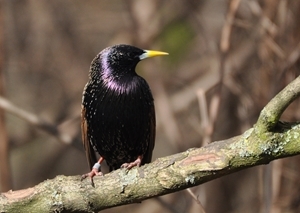 The Game and Wildlife Conservation Trust (GWCT) together with the Farming & Wildlife Advisory Group (FWAG) is giving farmers an opportunity of learning how to identify the everyday birds that live on their farms by attending a farmland bird ID day on the 5th February at Little Braxted, Witham, Essex.
The Game and Wildlife Conservation Trust (GWCT) together with the Farming & Wildlife Advisory Group (FWAG) is giving farmers an opportunity of learning how to identify the everyday birds that live on their farms by attending a farmland bird ID day on the 5th February at Little Braxted, Witham, Essex.
The aim of the training is to help farmers participate in the GWCT’s 2015 Big Farmland Bird Count which will take place between 7th and 15th February 2015. So far more than 1,600 farmers are registered to take part in this country-wide survey.
Kit Speakman, the Essex Chairman of FWAG East is delighted that his Association can offer support to the GWCT’s Big Farmland Bird Count by organising this special bird ID day.
He said, “We’ve decided to run this event because I think it’s really important that as many people as possible get behind the count and brush up on their birding skills. We all spend a lot of time fussing over our margins and manicuring our mixes, and we KNOW they deliver for wild birds, but can we identify them? We all enjoy seeing flocks of small birds feeding on our seed, swooping over our hedgerows and darting for cover, but how can we demonstrate the value of our efforts unless we know exactly what we are attracting onto our farms?
“At the event I’m looking forward to hearing from expert FWAG birder Tim Schofield on identifying the different species and putting this into practice on my farm, so that I can contribute meaningfully to the count between 7th-15th February. It’s time we take our conservation efforts full circle, make them measurable and let the public know how we are supporting farmland birds.”
The GWCT believes that the efforts being made by farmers to reverse bird declines frequently go unrecognised despite them being vital in safeguarding the future of many of our most cherished bird species such as skylark, yellowhammer, corn buntings and wild grey partridges.
Jim Egan from the GWCT explains, “Our Big Farmland Bird Count helps to remedy this as it showcases some of the remarkable conservation efforts being carried out by farmers, landowners and gamekeepers such as providing supplementary over-winter food or by growing wild bird seed mixes. It is also a useful way to measure how birds are faring on our farms across the country. Once farmers are aware of what birds they have on their farm, they can more accurately target the recovery of individual species by putting in place specific conservation measures.”
For those interested in taking part in the Big Farmland Bird Count, the GWCT is providing a simple tick sheet that can be downloaded from the GWCT’s website and taken into the field to record any sightings. Participants will then be able to send the results either via a dedicated web page or through the post. The GWCT is inviting people to spend about half an hour recording the species and number of birds seen on one area of the farm. To download information, please visit: www.gwct.org.uk/bfbc.
The GWCT’s Big Farmland Bird Count has captured the imagination of all those interested in the future of farmland birds. Sponsored by BASF, the count is run in partnership with the FWAG Association and LEAF and receives grateful support from a wide range of farming and industry organisations such as RSPB, Kings, Waitrose, NFU, Soil Association, CFE, CLA, Heather Trust, Conservation Grade, and Countryside Alliance
Although the Bird ID Day being organised by FWAG East is full, it is possible to book on a course planned for next year. Please contact Jilly McNaughton at FWAG East on telephone: 01223 841507. For more information on the GWCT’s Big Farmland Bird Count, please contact: Morag Walker by email: mwalker@gwct.org.uk or by phone: 07736 124097
END
Photocaption: Starlings were seen on over 40% of the farms taking part in the GWCT’s 2014 Big Farmland Bird Count and were the most abundant bird recorded. Starling numbers have declined markedly across much of northern Europe and the UK. Picture credit: Peter Thompson, GWCT.
Notes to editors
The Game & Wildlife Conservation Trust – providing research-led conservation for a thriving countryside. The GWCT is an independent wildlife conservation charity which has carried out scientific research into Britain’s game and wildlife since the 1930s. We advise farmers and landowners on improving wildlife habitats. We employ more than 60 post-doctoral scientists and other research staff with expertise in areas such as birds, insects, mammals, farming, fish and statistics. We undertake our own research as well as projects funded by contract and grant-aid from government and private bodies.
For information, contact:
Eleanor Williams
Telephone: 07592 025476
Email: press@gwct.org.uk